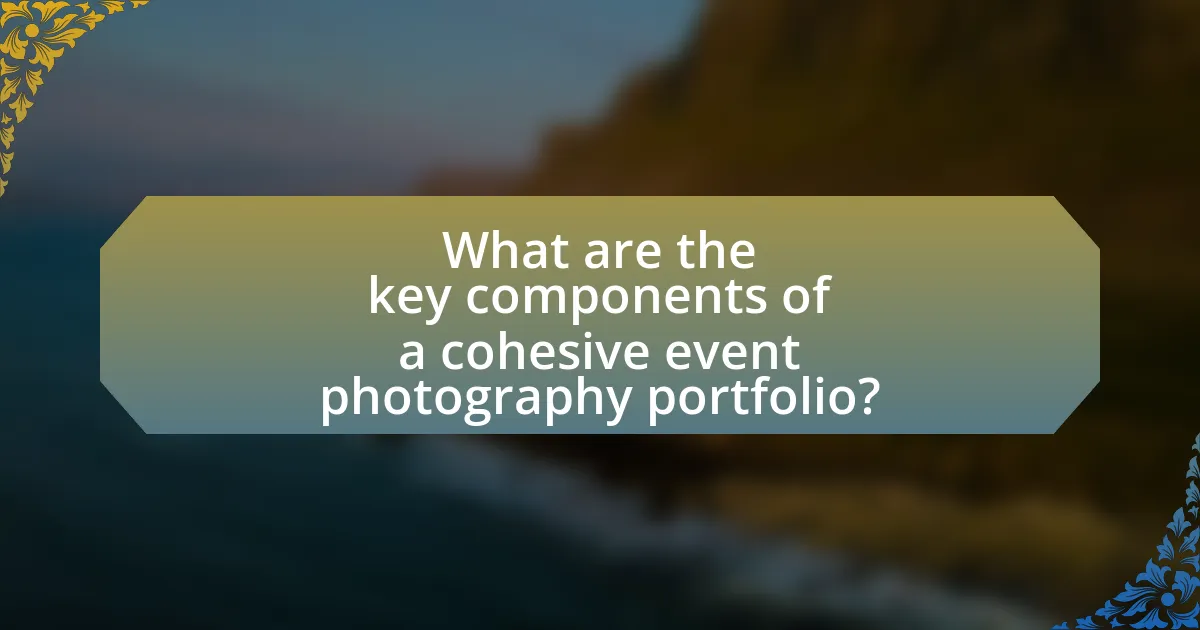A cohesive event photography portfolio is a carefully curated collection of images that consistently reflects a specific style, theme, or narrative across various events. This article outlines the importance of a cohesive portfolio for event photographers, highlighting how it differs from a standard portfolio by presenting a unified aesthetic and emotional tone. Key components such as consistent visual style, thematic unity, and strong storytelling are discussed, along with strategies for selecting images, enhancing presentation, and effectively showcasing the portfolio to potential clients. Additionally, the article emphasizes the role of client testimonials and feedback in establishing credibility and improving the portfolio over time.

What is a Cohesive Event Photography Portfolio?
A cohesive event photography portfolio is a collection of images that consistently reflects a specific style, theme, or narrative across various events. This type of portfolio showcases the photographer’s ability to capture moments in a unified manner, ensuring that all images resonate with a similar aesthetic and emotional tone. For instance, a cohesive portfolio may feature consistent color grading, composition techniques, and subject matter that align with the photographer’s artistic vision, making it easier for potential clients to understand their unique approach to event photography.
How does a cohesive portfolio differ from a standard portfolio?
A cohesive portfolio differs from a standard portfolio in that it presents a unified theme or style, enhancing the overall narrative and visual impact. While a standard portfolio may showcase a variety of unrelated works, a cohesive portfolio strategically selects images that complement each other, creating a consistent aesthetic and emotional resonance. This approach is particularly effective in event photography, where a cohesive portfolio can highlight the photographer’s unique vision and storytelling ability, making it more appealing to potential clients.
What elements contribute to the cohesiveness of a portfolio?
The elements that contribute to the cohesiveness of a portfolio include a consistent visual style, thematic unity, and a clear narrative. A consistent visual style ensures that all images share similar color palettes, lighting, and composition techniques, which helps create a unified look. Thematic unity involves selecting images that reflect a common subject or emotion, reinforcing the overall message of the portfolio. A clear narrative guides viewers through the portfolio, allowing them to understand the story behind the images. These elements work together to create a cohesive presentation that effectively showcases the photographer’s skills and vision.
How does visual consistency enhance a portfolio’s impact?
Visual consistency enhances a portfolio’s impact by creating a unified aesthetic that reinforces the photographer’s brand identity. When a portfolio exhibits consistent color schemes, styles, and compositions, it allows viewers to easily recognize the photographer’s work and understand their artistic vision. Research indicates that visual consistency can increase viewer engagement and retention; for instance, studies show that cohesive visual elements can improve memory recall by up to 80%. This cohesive presentation not only attracts potential clients but also establishes professionalism and credibility in the competitive field of event photography.
Why is a cohesive portfolio important for event photographers?
A cohesive portfolio is important for event photographers because it showcases their unique style and consistency in capturing moments. This consistency helps potential clients quickly assess the photographer’s capabilities and aesthetic, making it easier for them to decide if the photographer aligns with their vision for an event. Research indicates that 70% of clients prefer to hire photographers whose work reflects a distinct and recognizable style, which reinforces the need for a cohesive presentation. By presenting a unified body of work, event photographers can effectively communicate their brand identity and attract the right clientele.
How does a cohesive portfolio attract potential clients?
A cohesive portfolio attracts potential clients by showcasing a consistent style and quality that reflects the photographer’s unique brand. This consistency helps clients quickly assess the photographer’s capabilities and envision how their vision aligns with the photographer’s aesthetic. Research indicates that 75% of consumers judge a company’s credibility based on its website design, which includes portfolio presentation. Therefore, a well-organized and visually appealing portfolio can significantly enhance a photographer’s appeal, leading to increased inquiries and bookings.
What role does a cohesive portfolio play in showcasing a photographer’s style?
A cohesive portfolio plays a crucial role in showcasing a photographer’s style by presenting a unified visual narrative that reflects their artistic vision and technical skills. This consistency allows potential clients to easily identify the photographer’s unique aesthetic, making it easier for them to determine if the photographer’s style aligns with their needs. Research indicates that a well-curated portfolio can significantly influence client decisions, as 70% of clients prefer to hire photographers whose work demonstrates a clear and consistent style.

What are the key components of a cohesive event photography portfolio?
A cohesive event photography portfolio consists of a consistent style, a variety of event types, strong storytelling, and high-quality images. Consistent style refers to the uniformity in editing, color grading, and composition across the portfolio, which helps establish a recognizable brand identity. A variety of event types showcases versatility, demonstrating the photographer’s ability to capture different atmospheres, such as weddings, corporate events, and parties. Strong storytelling is essential, as it allows the photographer to convey emotions and narratives through images, making the portfolio engaging. High-quality images are crucial, as they reflect professionalism and technical skill, ensuring that each photograph is sharp, well-composed, and properly exposed. Together, these components create a compelling and cohesive presentation that attracts potential clients.
How should you select images for your portfolio?
To select images for your portfolio, focus on showcasing your best work that reflects your unique style and versatility. Prioritize high-quality images that demonstrate your technical skills, creativity, and ability to capture emotions and moments effectively. Aim for a cohesive theme or narrative throughout the portfolio, ensuring that the selected images complement each other in terms of color, composition, and subject matter. Research indicates that a well-curated portfolio can significantly enhance a photographer’s chances of attracting clients, as it provides a clear representation of their capabilities and artistic vision.
What criteria should guide your image selection process?
The criteria that should guide your image selection process include relevance, quality, diversity, and storytelling. Relevance ensures that each image aligns with the theme and purpose of the event, while quality refers to technical aspects such as sharpness, exposure, and composition. Diversity involves showcasing a range of moments and perspectives to capture the event’s essence fully. Storytelling emphasizes the narrative conveyed through the images, allowing viewers to connect emotionally with the event. These criteria collectively enhance the cohesiveness and impact of an event photography portfolio.
How can you ensure a variety of events are represented?
To ensure a variety of events are represented in an event photography portfolio, actively seek out and include diverse types of events such as weddings, corporate functions, festivals, and community gatherings. This approach not only showcases versatility but also appeals to a broader audience. For instance, a portfolio that features a wedding, a charity gala, and a music festival demonstrates the photographer’s ability to adapt to different environments and subjects, which is crucial for attracting various clients. Research indicates that portfolios with diverse content are more likely to engage potential clients, as they reflect a comprehensive skill set and adaptability in different contexts.
What techniques can enhance the presentation of your portfolio?
To enhance the presentation of your portfolio, utilize techniques such as consistent visual themes, high-quality images, and clear organization. Consistent visual themes, including color schemes and typography, create a cohesive look that reflects your style and professionalism. High-quality images are essential; they should be well-composed and properly edited to showcase your best work effectively. Clear organization involves categorizing your work logically, such as by event type or chronological order, making it easy for viewers to navigate and understand your expertise. These techniques are supported by research indicating that visual consistency and quality significantly impact viewer engagement and perception of professionalism in portfolios.
How does layout and design affect viewer engagement?
Layout and design significantly influence viewer engagement by guiding attention and enhancing the overall user experience. A well-structured layout, with clear visual hierarchy and intuitive navigation, allows viewers to easily absorb information and encourages them to interact with the content. Research indicates that 94% of first impressions are design-related, highlighting the importance of aesthetics in capturing attention. Additionally, effective use of color, typography, and imagery can evoke emotions and create a connection with the audience, further increasing engagement levels.
What role does color grading play in creating a cohesive look?
Color grading plays a crucial role in creating a cohesive look by ensuring that all images share a consistent color palette and tonal range. This uniformity enhances the visual narrative and emotional impact of the portfolio, making it more engaging for viewers. Studies in visual perception indicate that cohesive color schemes can improve aesthetic appeal and viewer retention, as seen in research published in the Journal of Vision, which highlights how color harmony influences emotional responses to images.

How can you effectively showcase your portfolio to potential clients?
To effectively showcase your portfolio to potential clients, create a visually appealing and organized online presence that highlights your best work. Utilize a professional website or portfolio platform that allows for easy navigation and categorization of your event photography, ensuring that images are high-quality and relevant to the types of events you want to attract. Research indicates that 75% of consumers judge a company’s credibility based on its website design, emphasizing the importance of a polished presentation. Additionally, include client testimonials and case studies to provide social proof and demonstrate your experience and reliability in the field.
What platforms are best for displaying your event photography portfolio?
The best platforms for displaying your event photography portfolio include Squarespace, Wix, and Adobe Portfolio. Squarespace offers customizable templates specifically designed for photographers, enabling a visually appealing presentation of images. Wix provides a user-friendly drag-and-drop interface, allowing for easy portfolio creation with various design options. Adobe Portfolio integrates seamlessly with Adobe Creative Cloud, making it ideal for photographers who already use Adobe products, and it offers responsive designs that showcase images effectively. These platforms are widely recognized for their functionality and aesthetic appeal, making them suitable choices for event photographers looking to present their work professionally.
How can social media be utilized to promote your portfolio?
Social media can be utilized to promote your portfolio by sharing high-quality images and engaging content that showcases your event photography skills. Platforms like Instagram and Facebook allow photographers to reach a wider audience, as they support visual storytelling and community interaction. For instance, using relevant hashtags can increase visibility; a study by HubSpot found that posts with at least one hashtag receive 12.6% more engagement than those without. Additionally, collaborating with influencers or event organizers can enhance credibility and attract potential clients. Regularly updating your social media profiles with fresh content keeps your audience engaged and encourages sharing, further expanding your reach.
What are the benefits of having a personal website for your portfolio?
Having a personal website for your portfolio provides a centralized platform to showcase your work, enhancing visibility and professionalism. A personal website allows you to present your photography in a curated manner, making it easier for potential clients to navigate and appreciate your style. Additionally, statistics show that 75% of consumers admit to making judgments on a company’s credibility based on their website design, highlighting the importance of a well-crafted online presence. Furthermore, a personal website can improve search engine optimization (SEO), increasing the likelihood of being discovered by clients searching for event photographers.
How can you gather feedback to improve your portfolio?
To gather feedback to improve your portfolio, actively seek input from peers, mentors, and clients. Engaging with these individuals allows you to receive diverse perspectives on your work, which can highlight strengths and areas for improvement. For instance, conducting surveys or informal interviews can yield specific insights about the visual appeal, storytelling, and technical execution of your photography. Research indicates that feedback from multiple sources can significantly enhance creative output, as noted in studies on collaborative learning and peer review processes.
What methods can you use to solicit constructive criticism?
To solicit constructive criticism, you can use methods such as direct requests for feedback, anonymous surveys, and peer review sessions. Directly asking colleagues or mentors for their insights encourages open dialogue and specific suggestions for improvement. Anonymous surveys allow participants to provide honest feedback without fear of repercussions, which can lead to more candid responses. Peer review sessions involve sharing your work with fellow photographers who can offer diverse perspectives and constructive input. These methods are effective because they create an environment conducive to honest and actionable feedback, essential for refining your event photography portfolio.
How can client testimonials enhance your portfolio’s credibility?
Client testimonials enhance your portfolio’s credibility by providing social proof of your skills and reliability. When potential clients see positive feedback from previous clients, it builds trust and reassures them of your ability to deliver quality work. Research indicates that 79% of consumers trust online reviews as much as personal recommendations, highlighting the significant impact testimonials have on decision-making. By showcasing authentic testimonials, you demonstrate a proven track record, which can lead to increased client inquiries and bookings in the competitive field of event photography.
What are some best practices for maintaining a cohesive event photography portfolio?
To maintain a cohesive event photography portfolio, photographers should focus on a consistent style, theme, and color palette throughout their work. Consistency in editing techniques, such as using similar filters or color grading, helps unify the images, making the portfolio visually appealing. Additionally, selecting images that reflect a specific type of event or mood reinforces the theme, ensuring that the portfolio tells a coherent story. Research indicates that portfolios with a clear visual identity are more likely to attract clients, as they demonstrate a photographer’s unique perspective and expertise in a particular niche.
How often should you update your portfolio with new work?
You should update your portfolio with new work at least every six months. Regular updates ensure that your portfolio reflects your most current skills and style, which is crucial in the competitive field of event photography. According to a survey by the American Society of Media Photographers, 70% of clients prefer to see recent work, as it demonstrates an artist’s evolving capabilities and relevance in the industry.
What strategies can help you stay true to your photographic style over time?
To stay true to your photographic style over time, consistently practice and refine your techniques while maintaining a clear vision of your artistic identity. Regularly reviewing your past work helps identify the elements that resonate with your style, allowing you to focus on those aspects in future projects. Additionally, setting specific goals related to your style can guide your creative decisions, ensuring that you remain aligned with your vision. Engaging with a community of photographers who share similar interests can provide valuable feedback and inspiration, reinforcing your commitment to your unique approach.















